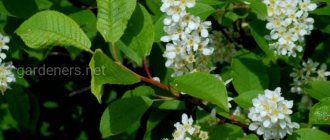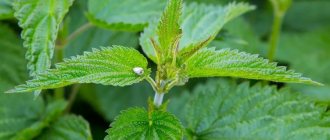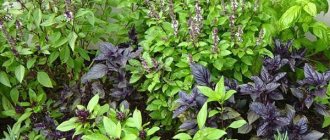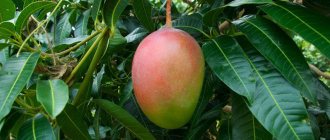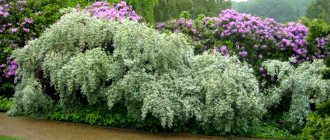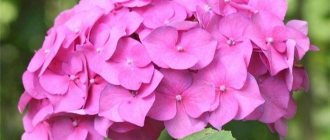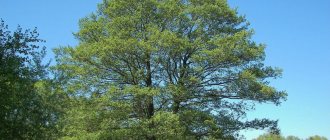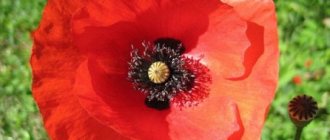Nettle (Urtica) is a large genus of annual or perennial herbaceous plants that belong to the dicotyledonous class, order Rosaceae, nettle family.
When creating botanical nomenclature, Carl Linnaeus left a generic name for this plant, received from Pliny the Elder. The etymology of the name is associated with the Latin words “uro” and “ussi”, meaning “to burn” or “to be burned”, eloquently speaking about the ability of the plant to cause noticeable painful burns to a person when its stems or leaves are touched. The Russian definition comes from two Old Slavonic words: “krapat” - meaning “to splash” and “okrop” - corresponding to the concept of “boiling water”. Thus, it turns out that nettle is a plant that burns like boiling water and leaves burns in the form of drops or splashes.
Nettle - description and characteristics
Depending on the species, nettle can be either a monoecious or dioecious erect plant with one stem and several lateral shoots. The height of nettle varies from 0.55 m to 2 m. The edges of nettle leaves, located opposite each other, are solid, with light or deep serrations, and also deeply dissected into 3-5 parts. The stipules located at the base of the petiole are paired and quite often fused together.
The stems and leaves of nettle are colored in various shades of green, and their surface is in most cases covered with a huge number of stinging hairs. Each of them is a kind of ampoule containing acetylcholine, serotonin, histamine, as well as formic acid, tartaric and oxalic acid. When it comes into contact with the body of a person or animal, the siliceous tip of the hair breaks off and penetrates under the skin, and along with it the contents of the “ampoule,” causing a chemical burn at the point of contact. Histamine, serotonin and acetylcholine cause pain and redness, while tartaric and oxalic acids, found in some types of nettles, are responsible for the duration of pain.
The branching inflorescences of nettle of the false-spike-shaped or paniculate type consist of small unisexual, less often bisexual, flowers.
Male flowers of stinging nettle
Male flowers of stinging nettle
Stinging nettle female flowers
Nettle fruit
Restrictions and contraindications
Like any remedy, stinging nettle has not only medicinal properties, but also contraindications. The plant requires caution in use. This applies to cases of treatment of bleeding requiring surgical intervention. Patients with increased blood clotting and kidney problems should also use the herb with extreme caution. Varicose veins, thrombophlebitis, thrombosis - these diseases can worsen with uncontrolled intake of the culture. The use of the plant is contraindicated for pregnant women.
Classification of nettles
The genus Urtica consists of more than 50 species of nettle, some of which are recognized by modern science as subspecies and synonyms. Below are the types of nettles with an indication of their growing area according to data from the website (www.theplantlist.org/tpl1.1/search?q=urtica):
- Urtica andicola
- Urtica angustifolia – Nettle leaf. Russia, China, Japan, Korea
- Urtica aquatica
- Urtica ardens. China.
- Urtica atrichocaulis. Himalayas, southwest China
- Urtica atrovirens. Western Mediterranean
- Urtica ballotifolia
- Urtica berteroana
- Urtica cannabina - Hemp nettle. Russia and Western Asia from Siberia to Iran
- Urtica chamaedryoides. Southeast North America
- Urtica circularis
- Urtica dioica - Stinging nettle. Europe, Russia, Asia, North America
- Urtica echinata
- Urtica ferox – Ongaonga nettle tree. New Zealand
- Urtica fissa. China.
- Urtica flabellata
- Urtica galeopsifolia – Nettle. Central and Eastern Europe, Russia
- Urtica glomeruliflora
- Urtica gracilenta. USA (Arizona, New Mexico, western Texas), northern Mexico
- Urtica haussknechtii
- Urtica hyperborea. Himalayas from Pakistan to Bhutan, Mongolia and Tibet
- Urtica kioviensis - Kiev nettle. Eastern Europe
- Urtica laetevirens – Light green nettle. Russia, Japan, Manchuria, Korea
- Urtica leptophylla
- Urtica lilloi
- Urtica longispica
- Urtica macbridei
- Urtica magellanica
- Urtica mairei. Himalayas, southwest China, northeast India, Myanmar
- Urtica masafuerae
- Urtica massaica
- Urtica membranacea. Mediterranean, Azores
- Urtica Mexicana
- Urtica minutifolia
- Urtica mollis
- Urtica morifolia. Canary Islands (endemic)
- Urtica orizabae
- Urtica parviflora. Himalayas
- Urtica pilulifera – Ball nettle. Southern Europe, Russia
- Urtica platyphylla – Flat-leaved nettle. China, Japan, Russia
- Urtica praetermissa
- Urtica pseudomagellanica. Bolivia
- Urtica pubescens – Hairy nettle. Northern Russia, central Asia
- Urtica purpurascens
- Urtica rupestris. Sicily (endemic)
- Urtica sondenii – Sonden's nettle. Northeastern Europe, northern Asia
- Urtica spiralis
- Urtica stachyoides
- Urtica subincisa
- Urtica taiwaniana. Taiwan
- Urtica thunbergiana - Thunberg nettle. Japan, Taiwan
- Urtica triangularis
- Urtica triangularis subsp. pinnatifida
- Urtica trichantha
- Urtica urens - Stinging nettle. Europe, Russia, North America
Types of nettles that grow in Russia:
- Urtica angustifolia – Nettle leaf
- Urtica cannabina - Hemp nettle
- Urtica dioica - Stinging nettle
- Urtica galeopsifolia – Stinging nettle
- Urtica kioviensis - Kiev nettle
- Urtica laetevirens – Light green nettle
- Urtica pilulifera – Ball nettle
- Urtica platyphylla – Flat-leaved nettle
- Urtica sondenii – Sonden's nettle
- Urtica urens - Stinging nettle
Types of nettles, names and photos
Below is a description of several varieties of nettles:
- Stinging nettle (Urtica dioica)
This is a perennial herbaceous plant with a well-developed creeping root system. The erect, hollow inside stem, having a tetrahedral cross-section, is abundantly covered with simple and stinging hairs. There is an abundant amount of burning hairs in the nodes. The height of the stem ranges from 0.6 to 2 m. At the beginning of the growing season, the nettle stem has a simple structure, however, starting from mid-summer, numerous axillary shoots form on it. The leaves of stinging nettle, painted dark green, have an elongated ovate-lanceolate or oval-heart-shaped shape. Their length can reach 5-17 cm, while the width of the leaves is 3-7 cm. The edges of the leaf blade are cut with rather deep teeth. The length of the petiole is 1-6 cm. Paniculate inflorescences consist of small unisexual flowers of pale green color. Nettle fruits are elliptical or ovoid in shape, their length is 1-1.3 mm, width - 0.8-1 mm. The flowering period of this type of nettle begins in the first ten days of May and ends in late autumn. Stinging nettle is widespread throughout almost the entire territory of Eurasia, as well as in most countries of North Africa, China, South-West and Central Asia. Also introduced to the North American continent and Australia. In Russia, nettle grows in forest and forest-steppe zones, ranging from the European part to the Caucasus, Eastern Siberia and the Far East. Thanks to its horizontal branching root system, dioecious nettle is capable of forming extensive thickets in damp meadows, along the banks of rivers and reservoirs, on deserted abandoned lands, along roads and fences.
- Stinging nettle (Urtica urens)
widespread in the Russian Federation, Germany, Poland, Romania, France and other European countries, as well as in North America. This is an annual plant with a powerful but rather short vertical root and a tetrahedral erect stem 15-50 cm high, the surface of which is covered with shallow vertical grooves. The small leaves of stinging nettle are dark green in color, reaching 1-6 cm in length and 1-4 cm in width, with a serrated edge, like the trunk, covered with numerous stinging hairs and a small number of simple hairs. The shape of the leaf blade can be oval or ovoid with a pointed nose. Unisexual small greenish nettle flowers can be either solitary or collected in spike-shaped inflorescences. The length of the petiole is 0.5-4 cm. Nettle fruits are ovoid in shape, their length is 1.5-2 mm, width - 1.1-1.3 mm. Ripe fruits usually have red-brown glands. Stinging nettle blooms from mid-May to late autumn.
- Kiev nettle (Urtica kioviensis)
grows in Germany, Poland, France, Spain, Italy, in other European countries, as well as in Palestine. It is listed in the Red Book and is distributed in the European part of Russia, Belarus and Ukraine. This is a perennial monoecious plant with numerous lodging herbaceous stems no more than 1.2 m high. The leaf blades are dark green in color and have an oblong-ovate shape with a jagged edge. The surface of nettle leaves and stems is covered with sparse, stinging hairs. The paniculate inflorescence bears male and female flowers. The growing season of this type of nettle continues until the onset of stable frosts, down to -5°C. Kiev nettle grows in marshy soils, in deciduous forests, along the banks of lakes, rivers and streams. Flowering lasts from early June to late July.
- Nettle (Urtica platyphylla)
grows in East Asian countries, China and Japan, in the Russian Far East, the Commander and Kuril Islands, Sakhalin and Kamchatka. It is a perennial plant with a short vertical root and a rather tall, erect stem and numerous thin side shoots. The height of the stem varies from 50 cm to 1.5 meters. The shape of the leaf blades can be ovoid or elongated-ovoid, their length varies from 4 to 20 cm, the width reaches 12 cm. The surface of the leaves, stem and side shoots of nettle is covered with stinging hairs. Paniculate or spike-shaped inflorescences, appearing in July-August, consist of very small flowers of a grayish-green color. Flat-leaved nettle blooms from July to October.
Photo by: Boris Bolshakov
- Nettle (Urtica angustifolia)
found in mixed mountain and riverine forests, along roads and in populated areas of China, Korea, Japan, and Mongolia. On the territory of Russia it grows in the Chita and Irkutsk regions, Krasnoyarsk Territory, Altai, Buryatia and the Far East. This is a perennial herbaceous plant with a height of 15 cm to 1.2 meters with creeping rhizomes and an erect stem with sparse side shoots. The leaf blades are elongated-lanceolate or lanceolate (sometimes ovate-lanceolate), 4-12 cm long, 1-4 cm wide, with a serrate edge, painted in various shades of green. Inflorescences are paniculate, strongly branched. The whole plant is covered with many simple hairs, among which there are a few stinging ones. Nettle fruits are elliptical, ovoid or rounded-ovoid, fruit length 0.8-1 mm, fruit width 0.7-1 mm. Flowering of angustifolia nettle begins in June and, depending on the place of growth, can last until October. Can form hybrids with stinging nettle and flat-leaved nettle.
Photo by: Natalya Surovtseva
- Hemp nettle (Urtica cannabina)
grows almost throughout the Russian Federation, Central Asia, Mongolia and China. It is mainly found along roads, in vacant lots, railway embankments, and in populated areas. This is a perennial plant with a powerful, horizontal, non-creeping root system and an erect tetrahedral stem with vertical ribs. The height of the nettle stem can reach 70-150 cm. Quite large leaves are dark green, up to 15 cm long, three-dissected or tripartite (with pinnately dissected segments). The stems and leaves are densely covered with clusters of fine stinging hairs and a small number of simple hairs. Inflorescences consist of many small unisexual flowers. The length of the petiole is 3-8 cm, which is 2-3 times shorter than the blade. Nettle fruits are ovoid or elliptical in shape, fruit length is 1.9-2.5 mm, fruit width is 1.2-2.8 mm. The flowering period of this type of nettle lasts from early June to mid-August.
Photo by: Lyudmila Palamarchuk
Photo by: Tamara Reeb
- Nettle (Urtica galeopsifolia)
grows in European countries, in the south of Russia (in the Caucasus). This is a perennial plant with a creeping root system. The height of the tetrahedral erect stem, densely pubescent with simple hairs and a few stinging hairs, can reach 2 meters. Nettle leaves are arranged oppositely and have an elliptical or oblong-ovate shape. The leaf length is 6-14 cm with a width of 2.5 to 5 cm. The nettle leaf has a round or heart-shaped base, as well as a pointed tip. There are usually no burning hairs on the leaf blade. The length of the petiole is 1.5-5 cm. Nettle fruits are ovoid or elliptical in shape, their length varies from 1 to 1.3 mm, and their width is 0.7-1 mm. This type of nettle can be found in damp marshy areas, in lowlands and near rivers, in forests and bushes.
Photo by: Galina Chulanova
Author of the photo: Evgeny Nosikov
- Sonden's nettle (Urtica sondenii)
perennial plant with a creeping root system, grows up to 1 meter in height. The nodes usually contain both burning and simple hairs. There are no hairs in the internodes. Nettle leaves have a narrow-ovate or oblong-ovate shape. The length of the leaf varies between 4 and 12 cm with a width of 1.5 to 4.5 cm. The apex of the leaf is pointed, the base is rounded, wedge-shaped. The leaf has 12-25 pairs of teeth. On the leaf blade only occasionally there are a few simple and stinging hairs, mainly located in large veins. The length of the petiole is from 1 to 6 cm. The nettle fruit has the shape of an ellipse or egg, the length of the fruit is 1-1.3 mm, the width is 0.6-1 mm. Sonden nettle grows in northern Europe, eastern Central Asia, and Russia. Usually this plant grows in forests and floodplains, meadows and near water bodies. It is very rare to find this type of nettle in cities or near roads.
Author of the photo: Natalya Glushkovskaya
- Light green nettle ( Urtica laetevirens )
perennial herbaceous plant that blooms from June to August. The stem, whose height is 40-100 cm, has stinging hairs. The pointed nettle leaves, serrated along the edges, have a broadly ovate shape. The upper inflorescences are long, staminate, the lower ones are short and intermittent pistillate. The fruit of nettle is an egg-shaped nut. Light green nettle grows in the Russian Far East, found at the foot of cliffs and in the shade of forests. Prefers broad-leaved, coniferous-deciduous and poplar forests.
- Nettle tree or ongaonga (Urtica ferox - “fierce nettle”)
grows exclusively in New Zealand. This is perhaps the only nettle with a woody stem, the height of which can reach 5 meters and a thickness of 12 cm. The stem with numerous branched side shoots and large leaves, 8-12 cm long and 3-5 cm wide, is densely covered with stinging hairs up to 6 mm long. The light green leaves have an elongated triangular shape.
Author of the photo: Alexey Seregin
- Nettle Urtica mairei
grows in southwest China, northeast India, the Himalayas, Myanmar, Nepal and Bhutan, where it is found in partially shaded moist forests, along the banks of streams, on roadsides and mountain slopes, and also near human habitation. It is a perennial herbaceous monoecious plant with a stolon-like root system and an erect stem with sparse lateral branches. The height of individual specimens rarely exceeds 1 m. The leaf blades, painted dark green, have a heart-shaped, ovoid, sometimes oblong shape. The length of nettle leaves is 10-15 cm, width - 3-6 cm. Petiole length is 3-8 mm. The inflorescences are unisexual, paniculate, 4-10 cm long, with small flowers of a grayish-green color. The fruits are light brown in color and have an oblong-spherical or spherical shape. The flowering period of nettle lasts from May to August.
- Ball nettle (Urtica pilulifera)
a perennial plant with a straight or ascending stem covered with a bluish coating, height from 20 to 75 cm. The leaves of ball-bearing nettle are quite wide (up to 9 cm), ovoid in shape, with a rounded base and a pointed apex. The inflorescences are collected in a spherical head. The fruit is a heart-shaped nut, no more than 3 mm long. This type of nettle is widespread in Crimea and the East Transcaucasian region. The plant loves landfills, roadsides, and is often found as a weed in cultivated crops.
Author of the photo: Tatyana Malchinskaya
Author of the photo: Tatyana Malchinskaya
Pests: how to deal with them
Stinging nettle
You should grow medicinal herbs in order to have a basis for quick treatment - stinging nettle is specially cultivated for this purpose. It is necessary to determine where the nettle is actively growing so that the environment for its development and formation is suitable. The substances contained in the plant negatively affect most pests that can enter the garden. That is why it is included in fertilizers or compost, which is then used to improve the composition of the soil (for flowers, cucumbers and other cultural plantings). Everyone knows what nettle looks like visually, so allowing it to grow in a certain area can then be used for its benefits. The popular name for growing nettle is stinging nettle, as it contains formic acid.
This is what effectively repels pests. You need to prepare a product to carry out irrigation; the result is useful for gardeners - accelerating the growth and development of crops, improving the quality of the crop.
Nettle is a source of vitamins for the body
To get positive changes, you need to know whether nettle is a herbaceous plant or not. It is known to be a weed that has small white flowers. The shape of the leaves has slight differences, as the species are diverse.
The following types are known:
- ramie;
- hemp nettle;
- water nettle.
Different types and varieties also have medicinal properties, but minor differences help expand the list of diseases that can be treated.
So, is nettle a shrub or a herb? Since it forms thickets, but each specimen grows independently, the plant does not belong to the shrubs. The People's Medical Directory recommends using decoctions and infusions to treat gastrointestinal diseases, but therapy should be started only after diagnosis by a doctor.
Since the habitat is wide, there is no shortage of this plant. You need to choose one convenient type of preparation of the compositions in order to get the maximum positive effect. The plant, from which the necessary components in the healing composition come from, can be used young or dried.
0 0 votes
Article rating
Chemical composition of nettle
Nettle is a real storehouse of vitamins and elements valuable for human health. It contains:
- ascorbic acid (twice as much as in blackcurrant berries);
- vitamins K, E and B;
- beta-carotene;
- chlorophyll and phytoncides;
- organic sugars and fiber;
- glycosides;
- tannins;
- oil (in plant seeds);
- iron, manganese, boron, nickel, copper.
Such a rich combination of beneficial substances determines the multifaceted use of nettle leaves and other parts in a wide variety of areas - from cooking and cosmetology to medicine.
Properties of culture
Dead nettle - what is it?
The use of nettle is due to its properties.
The plant is used:
- for medical purposes – a source of vitamins and microelements necessary for the body to function properly, strengthen the immune system, and prevent inflammatory processes;
- in cosmetology - the basis for masks and rinses;
- in cooking - used for preparing salads and first courses.
The plant in the rinse has a positive effect on the hair structure
It is necessary to know all the information about nettle in order to use it with maximum benefit or avoid unpleasant moments if a person has contraindications to the plant. There is no need to specifically look for information on how to grow a medicinal element, since the herb grows almost everywhere, including cities. The rich formula, rich in vitamins, microelements and other beneficial substances, determines the use of the herb in various areas.
It is important to know in advance what vitamins are contained in nettles before using them.
The composition determines the high content of formic acid; the juice and other parts also contain:
- tannins;
- flavonoids;
- vitamins (K, C, E, H, PP, various vitamins from group B);
- cellulose;
- aspartic acid;
- iron;
- selenium;
- lignins;
- polysaccharides;
- set of amino acids;
- potassium;
- cobalt;
- nickel.
The juice, which is healing for humans, explains the effect of increasing the percentage of hemoglobin in the blood. Its coagulability also improves, so the herb is included in therapy after operations or bleeding.
A decoction is used to treat:
- boils;
- acne;
- lishaev.
It is recommended to use decoctions, teas and infusions based on nettle during menstruation. The healing effect appears very quickly, especially when a young leaf is used. Traditional medicine also works effectively in other cases - nettle and quinoa are weeds, but the former removes toxins well, so gardeners get rid of this plant less actively. The body is strengthened thanks to vitamins C, E, K, B.
Interesting fact. Nettle has a positive effect on the hair structure, so rinsing with this herb should be a mandatory procedure when restoring it.
Nettle-based decoctions and teas are used in therapy
The basic rule is not to use juice or liquid containing nettle before consulting a doctor, as there are contraindications.
The main prohibitions apply to people with the following health problems:
- problems with blood clotting (prohibition on using the plant in any form);
- there are varicose veins;
- hypertension was diagnosed (even in its mild form).
The most important ban on the use of nettle concerns pregnant women - the substances in the composition can cause contractions and premature birth. Nettle, as a medicinal plant, is also prohibited at the beginning of pregnancy, as it can provoke contractions. It should be taken into account that the nettle herb effectively treats, but can also quickly cause harm to health.
It is completely contraindicated in case of individual intolerance or a high probability of developing an allergic reaction to one or another component. The plant fiber of this plant can be harmful when treated with components and drugs to relieve depression.
If a person has insomnia and uses medications to relieve this condition, then nettle should not be included in therapy or culinary dishes. This is due to the fact that the complex of substances enhances the effect of special medications.
Among the diseases that are contraindications for humans to use nettle are thrombophlebitis and atherosclerosis, since the components actively thicken the blood. If hypertension is present, then as a result of the ingress of substances from nettle juice, the blood vessels become toned, and the pressure increases significantly. Treatment with dried or fresh nettle is prohibited when bleeding occurs due to gynecological problems: cysts, polyps and other types of uterine tumors.
Nettle fertilizer promotes rapid growth of cultural plantings
Refusal for use should be severe kidney disease, as well as age under 15 years. Indications and contraindications apply to all members of the family, since the properties of nettle are mostly the same. Proper use can only be prescribed by a doctor. You should choose a preparation method based on the main problem that will need to be solved with nettle juice.
Nettle - medicinal properties and uses
- Nettle has long been used in cooking. Young leaves and shoots are used to prepare various sauces, borscht, soups and cabbage soup. In their raw form, nettle leaves are added to dietary salads. Often nettle greens are pickled for future use in the winter or dried to make tea. Powder from specially processed leaves is used as a component for the production of vitamin seasonings, as well as confectionery and meat products.
- Steamed nettle shoots are added to cows' feed to increase milk yield and increase the fat content of milk, and chopped nettle greens are given to laying hens to increase their egg production.
- Nettle is indispensable in the production of light, strong, environmentally friendly fabrics, as well as ropes and ropes.
- The food, perfume and pharmaceutical industries cannot do without chlorophyll, which is produced on an industrial scale from nettles.
- But this plant has found its greatest use in medicine, both folk and traditional. Infusions of nettle leaves have long been used to stop bleeding of any nature, including uterine and gastrointestinal. Many stomach preparations contain an extract from nettle leaves.
- In addition, nettle is a raw material for the production of cosmetic products for facial skin and hair care. Pharmaceutical preparations or self-prepared products based on nettle extracts are recommended for the treatment of weakened hair and scalp. Nettle tincture or shampoo with an extract of this plant perfectly stimulates the proper functioning of capillaries, accelerates the flow of oxygen and essential nutrients to the hair follicles, and optimizes metabolic processes. Healing masks are prepared from crushed nettle leaves by steaming the raw material with boiling water and applying the cooled pulp to the hair. Such procedures are excellent for seborrhea and hair damage.
Puree of young nettle leaves
Soap with stinging nettle extract
Nettle fabric
Nettle yarn
Nettle recipes - features of healthy nutrition
In spring there are no fresh vegetables, and the body is in dire need of vitamins. At this time, nettle dishes can serve as a valuable aid in nutrition. It is believed that nettle leaves are not inferior in nutritional value to green peas, beans, and legumes.
In the hungry war and post-war years, nettle turned out to be almost the main food for barefoot children. They ate it along with quinoa and sorrel from early spring until late autumn. And their mothers managed to prepare many dishes from this plant - cabbage soup, salads and liquid flatbreads.
To prepare delicious dishes from nettles, you do not need to have any special culinary talent. And the only problem here is where a city dweller can find environmentally friendly grass. Without a doubt, the nettle that grew within the city is not suitable for food.
You can make a nettle salad
To prepare it, you need to take well-washed young nettle leaves and chop them in a bowl, then add green onions, parsley and dill - mix all this, gradually adding vegetable oil. Salt, pepper - to taste.
You can make soup with nettles
Place diced potatoes (2 tubers) into the meat broth and cook until done. Then we take finely chopped young leaves of nettle, lungwort and sorrel and add to the soup, then wait 1-2 minutes until it boils and remove from heat. The soup can also be seasoned with sour cream and sprinkled with green onions and dill on a plate. Salt, pepper - to taste.
Nettles can be prepared for the winter. The leaves picked from May to September are dried in a draft, laid out so that they are not touched by direct sunlight.
Growing nettles at home
Today, many herbalists grow nettles at home to prepare medicines. Despite the fact that many types of nettle are weeds, this process requires some effort.
The main condition for successfully growing nettles is the correct choice of planting site. It is necessary to select a well-moistened and shaded area with sandy or fertile soil that is free of perennial weeds. Nettles are sowed in late autumn, before the onset of frost, or in the spring immediately after the snow cover melts. Nettle seeds mixed with fine dry sand are sown in grooves no more than 1.5 cm deep, after which they are sprinkled with a thin layer of peat or humus. The distance between adjacent grooves should be at least 0.6-0.7 m.
After sowing, the area is abundantly moistened and maintained in this condition until the first shoots appear. This usually happens when the average air temperature rises to +8°C, in the second half of April or early May.
When growing nettles by cuttings, in the spring you need to dig up rhizomes near the mother plant and cut them into planting material 8 to 10 cm long. The cuttings are immediately planted in the ground to a depth of no more than 8 centimeters with an interval of about 0.6 m. At first the plant may look weakened, however, after 40-50 days, its condition stabilizes, and the seedling grows sharply.
Caring for nettle plantings is quite simple. You only need to periodically weed the weeds, loosen the soil and water the area. Fertilizing with natural organic fertilizers gives good results.
Where can I buy nettles or their seeds?
Buying nettle seeds is not that difficult. If they are not available at your nearest pharmacy (and most likely they can be found there), then you can buy nettle or its seeds by ordering it online. You just need to look at the websites of companies that specialize in selling seeds of medicinal plants. And then you will be able to grow this medicinal plant on your site. Fortunately, it is unpretentious and does not require special care. And then the nettle will be able to give its owner all its strength. With the help of which you can maintain health for many years.
Interesting facts about nettles
- Burns received from contact with the plant are quite harmless, but touching the nettle tree (lat. Urtica ferox), which grows in New Zealand, causes great suffering to a person. Despite this, nettle leaves are the basis of the diet for the larvae of the Red Admiral, a butterfly common in New Zealand.
- In extreme conditions, nettle leaves are used to preserve some perishable foods. Even in extreme heat, fish or meat covered with nettle leaves stays fresh for several hours.
- In England and some other countries, wine is made from nettle leaves.
- In ancient Rus', nettle had several nicknames, among which was “fire-grass”. This plant was considered to be a fire element, so it was believed that it was under the protection of Perun and should only be cut with a very sharp knife.
- The heroine of H. H. Anderson's fairy tale "The Wild Swans" freed her brothers from evil spells with the help of shirts woven from nettles.
- It is believed that this plant is a stimulant and increases performance and endurance, so nettle decoctions were given to soldiers before battle, and powder from dried and ground leaves was sprinkled on wounds to stop bleeding.
Did you like the article? Share with your friends:
